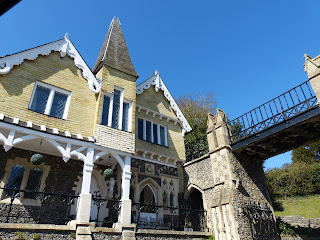Modern Brits are so attached to foreign holidays that "staycation" typically means not leaving the country.
Not leaving home? Now that's a stretch.
It's no surprise that my wanderlust fit well amongst the English; other than Christmas, I don't think I've ever taken off work and not gone somewhere. But I'm doing it now. With three intense months at my back I simply don't have the energy to wait until lockdowns lift and hotels open. Thus I'm embarking on two weeks Chez Bencard, without even local museums, stately homes and restaurants open to make things memorable. What's a holiday sightseer to do?
I've decided to treat my home territory as if I were a foreign tourist, going out on an excursion every day to learn about, photograph and walk around spots I may take for granted in my daily life. Pandemic lockdowns take interiors off-limits, so my explorations will be about exteriors, views and outdoor rambles. First up: Basingstoke.
If you want to see how the English class system is still alive and well, tell upper-middle class professionals you've moved to Basingstoke. Their inherent politeness will prevent them from saying what they really think, but for just a moment as they master their surprise their faces will register a mix of surprise and horror. Then will come the understanding consolation. "I suppose the commuting is good from there, eh?"
Why the disdain? In modern minds Basingstoke is perhaps best known for its role in post-war slum clearances from London. Government money poured into the place in the 1960s to fund great swathes of social housing into which some of the capital's poorest were re-located. The architecture was dismal and oppressive. However, as an informative exhibit in the town centre's museum points out, the new housing was considered luxurious by people who'd had little access to indoor plumbing, space or fresh air.
The town grew steadily but poor architectural choices continued. Brutalist office blocks and grimy overpasses line the motorway-like main drag through town. Strip malls, office parks and industrial estates ring the town centre. Doubtless trying to improve things, civic worthies in the early 1970s bulldozed much of the town centre and replaced it with a shopping mall and car-parks. It is, on first glance, a charmless, down-at-heel amalgamation of cement, steel and eye-punishing signage that is only made palatable by its transport links. (And perhaps by Berry Bros. & Rudd's HQ in one of those industrial estates.)
Yet Basingstoke is not a "New Town" like Basildon, Bracknell or Milton Keynes. The links that make it beloved of today's commuters and warehouse managers run along pathways that have been here since pre-historic times. The original name, Embasinga stocæ, goes back to an Anglo-Saxon tribe known as the Basingas, led by one Basa. All of the "Basings" are homes of Basa's people. Basingstoke saw the defeat of King Aethelred by the Danes in 871, was a thriving market town by the time it turned up in Domesday and was sophisticated enough to host Katherine of Aragon overnight as she journeyed to the English court for the first time from her native Spain.
There's more existing from Tudor and Medieval times than you'd think, but you have to look hard. The most picturesque are the ruins of the mortuary chapels just northwest of the train station.
The chapels once held the remains of, and services for, the great and the good of the area. Destroyed in the Civil War, they're just picturesque ruins now, but heavily-worn monuments like that of Sir William de Brayboeuf (below) give a sense of the magnificence of the place.
The chapels would have once looked down upon St. Michael's church, sitting in a green valley beside a tributary of the River Loddon. The church is still there, though the view is blocked by the train station and the bulk of The Anvil Theatre. I suspect most shoppers in Festival Place never realise that a historic monument lies just out M&S' back door.After Jane, the town's most famous association is with Thomas Burberry, a local draper whose early observations of how shepherd's smocks seemed to become resistant to weather after their wearers handled lots of sheep led him to develop waterproof gabardine. His outerwear would no doubt have been popular in any circumstance, but a lucrative army supply deal during WW1 and direct endorsement from the king ensured his fortunes. His headquarters and factory, once in the Top of Town, are long gone. But his greatest legacy is undoubtably the Regency-era house and grounds he purchased and later donated to the town.These days the Council occupies newer buildings around it, leaving Burberry's legacy to be used for special events and weddings. It also forms the gateway to War Memorial Park, created from the house's original grounds and marked by the town's monument to the conflict from which Burberry made his fortune.
Other shopfronts, the town's majestic Fairfields School and the opulent cemetery caretaker's cottage (where cricket commentator John Arlott was born) attest that Basingstoke was a prosperous and gracious place in Burberry's time.






































No comments:
Post a Comment